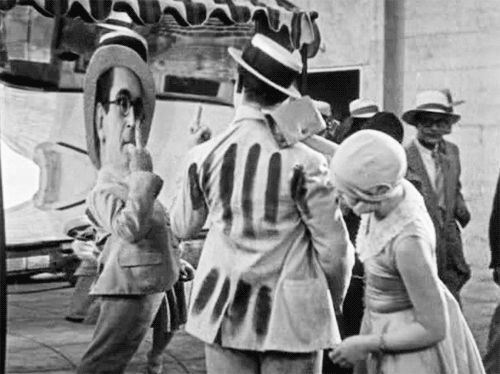THE MAGIC FLUTE (Bergman, 1975)
Criterion Collection, Blu-ray, Release Date Mar 12, 2019
Review by Christopher S. Long
The plot of Mozart's “The Magic
Flute” never really made much sense. Prince Tamino's first
accomplishment is to faint while fighting a dragon. This leads the
Queen of the Night and her assistants to identify him as just the man
to rescue the Queen's kidnapped daughter, Pamina. They probably just
think Tamino's hot, which is fair enough. The Queen gives the prince
a magic flute that will help him in his quest, but it doesn't really
do much, and anyway, Tamino discovers that the kidnapper, Sorastro,
isn't such a bad guy after all. A big battle brews at the end, but
the bad guys just suddenly disappear, and everyone else lives happily
ever after. Or maybe not, I'm not entirely sure. The End.
None of this has prevented millions
from falling in love with one of the most-performed operas of all
time, with Swedish director Ingmar Bergman proudly numbering himself
among its biggest fans. Bergman actually tried to stage the opera in
his childhood puppet theater, but wouldn't get to fulfill his dream
until the much-ballyhooed 1975 release of his film adaptation.
After a few bucolic outdoor shots,
Bergman moves into the theater (a recreation of the Drottningholm
Theater, built in the 18th century in Stockholm) and
lingers on the faces of the audience members as they listen to the
overture. Though he focuses on a smiling little girl, Bergman shows
close-ups of a diverse collection of opera enthusiasts of many ages
and races, suggesting his eagerness to share his love of this opera
with the whole world. To be honest, I found this extended montage of
face it a bit on the interminable side, but it's certainly heartfelt.
Though Bergman made some substantive
changes to the material (Sarastro is now Pamina's father, which casts
the Queen of the Night as an embittered ex-wife), he and
cinematographer Sven Nykvist present a fairly straightforward staged
opera, though with a few playful looks backstage, including the Queen
of the Night (Birgit Nordin) taking a smoke break at intermission.
The action moves briskly as Bergman delights in underscoring the
grand artifice of the big show, with unconvincing (yet charming)
costumed creatures cavorting in the background and the actual text of
the lyrics at times draped above the actors.
As Prince Tamino and Princess Pamina,
Josef Kostlinger and Irma Urrila are little more than a blandly
virtuous prince and a princess in need of rescuing, but they were
cast to sing which they do pretty darn well. Hakan Hagegard steals
all his scenes as the comic-relief chatterbox Papageno, whose
function has always been to steal pretty much every staging of “The
Magic Flute” so Bergman's just observing tradition here. Nordin
shreds it as the Queen of the Night. Is “shreds it” standard
opera criticism? Sorry, I am but a novice.
Video:
The film is presented in its original
1.37:1 aspect ratio. The film was digitally restored in 2017 by the
Swedish Film Institute. Criterion originally released this on DVD in
2000 (it retains Spine Number 71) with a transfer many considered
subpar by the company's high standards. This high-def restored
transfer showcases warm colors and a bright overall look. The image
generally looks a bit soft, or at least not as sharp as the best
Criterion 1080p transfers, but it's still a strong effort. I don't
own the old DVD as a comparison point, but from everything I've read
and stills I've seen online, this looks like a substantial upgrade.
Audio:
The music for the film was prerecorded
with Eric Ericson as orchestral director, and the singers mimed to
their lines for the film. The lossless stereo mix captures the score
quite robustly with no dropoff or any evident weaknesses at all.
Optional English subtitles support the Swedish audio.
Extras:
The original Criterion DVD release was
bare bones. This Blu-ray upgrade isn't exactly packed with extras,
but offers a few interesting supplements.
In a new interview (2018, 18 min.),
critic Peter Cowie discusses the film's production history and
provides some analysis of the unique Bergman touches added to
Mozart's opera.
The disc also includes an interview
with Bergman (29 min.), conducted by Sigvard Hammar, which originally
aired on Dec 27, 1974, in tandem with the film's holiday release.
Bergman casts himself as a populist, making an opera that the whole
family can enjoy.
“Tystnad! Tagning! Trollflojten!”
(1975, 65 min.) is a behind-the-scenes documentary which originally
aired on Swedish TV on Jan 6, 1975. I found it a bit dull and
rambling, to be honest, but fans might enjoy some of the looks at the
film's crew hard at work.
The slim fold-out booklet includes an
essay by author Alexander Chee.
Final Thoughts:
Bergman's “The Magic Flute” is
often described as one of the best filmed operas, a judgment I'm not
qualified to assess. It's certainly a fun ride, a much more sprightly
and pleasant film than some viewers might expect from the stern
Swede, but then again he directed his fair share of comedies. Like
“The Seventh Seal.” Seriously, that's a damn funny movie –
Gunnar Bjornstrand's sarcastic squire cracks me up every time.











